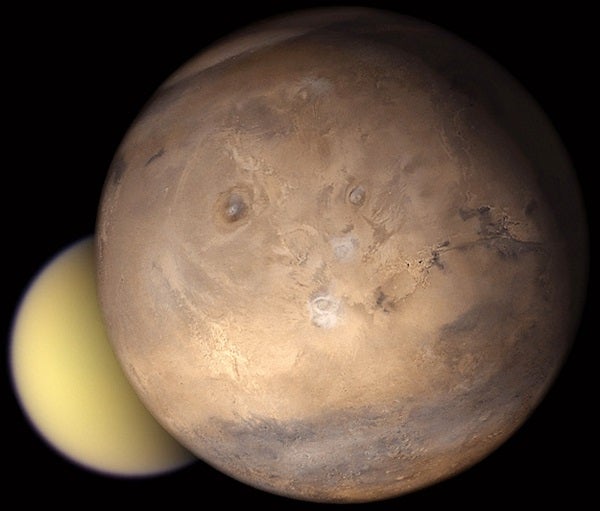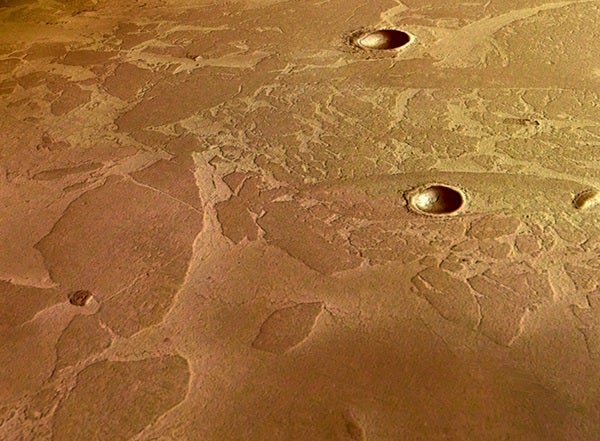At first glance, Saturn’s smoggy moon Titan and the planet Mars appear to have nothing in common but their color palette. But the atmospheres of both worlds contain an unlikely molecule: methane. Because ultraviolet sunlight easily breaks up methane, its detection implies a recent source. Volcanic eruptions, hydrothermal vents, and even life are among the explanations scientists have offered.
Now, in separate studies, researchers suggest methane-enriched ice may feed the atmospheres.
The ice, called a clathrate hydrate, forms at high pressures and low temperatures. Methane clathrates consist of single molecules of natural gas trapped within crystalline cages formed by frozen water molecules. On Earth, this ice is widespread in cold sea beds near continental shelves and occurs on land in permafrost and ice sheets.
The European Space Agency’s (ESA) Huygens probe landed on Titan last year, revealing a spectacular landscape carved by what many believe to be liquid methane rivers. One of the spacecraft’s instruments punched into the moon’s soil and detected methane gas wafting up from below.
Gabriel Tobie and Christophe Sotin at the University of Nantes in France and Jonathan Lunine at the University of Arizona, Tucson, used findings from Huygens and the NASA/ESA Cassini mission to model Titan’s evolution. The scientists suggest methane clathrate forms a crust above an internal water-ammonia ocean.
“This is the direction current thinking has been driven now since Huygens found very little primordial argon in Titan’s atmosphere last year,” says Bashar Rizk of the University of Arizona, Tucson. Rizk, who is not affiliated with the study, led the Huygens imaging team and writes about Titan in Astronomy‘s May issue.
Huygens found Titan’s atmosphere depleted in primordial argon (argon-36) compared to argon-40, an isotope that forms through radioactive decay. Moreover, these were the only members of the “noble gas” family — which includes helium, neon, and xenon — Huygens detected. Rizk says this means Titan’s original atmosphere has been replaced by what we observe there today. “Titan’s atmosphere is secondary and the result of episodic outgassing from the interior,” he explains.
Tobie’s team, writing in the March 2 issue of Nature, suggests Titan’s outer crust began cooling more rapidly during the past 500 million years. The moon’s subterranean ammonia-water ocean began to freeze solid. As this crystallization progresses, the freezing ocean expands. Plumes of ice extend upward into the moon’s methane clathrate crust and ultimately give rise to Titan’s volcano-like outflows. This “cryovolcanism” involves eruptions of flowing ice instead of rock. The icy plumes disturb the methane clathrate in Titan’s crust and make it unstable, which frees methane molecules from their frozen cages.
“These outbursts could produce temporary flows of liquid methane … accounting for the river-like features seen on Titan’s surface,” says Tobie. The researchers believe the ammonia-water ocean is still present a few tens of miles below Titan’s surface, and that methane outgassing is still going on. “Release of methane through cryovolcanic eruptions should still occur on Titan,” he adds.
Cassini images have already identified at least one possible cryovolcano. “Cassini’s instruments … should detect an increasing number of cryovolcanic features and, if we are lucky, may eventually detect eruptions of methane,” Tobie adds. Measurements planned for later in the probe’s mission may determine whether or not the suspected internal ocean actually exists.
In March 2004, an instrument aboard the ESA’s Mars Express measured the Red Planet’s atmospheric methane at concentrations of 10 parts per billion. Under current martian conditions, ultraviolet light will break up the gas in less than 430 years, which implies a recent or sustained source. Mars has many dormant volcanoes that could be venting small amounts of the gas from deep reservoirs. The most exotic explanation: The methane arises from bacteria living under the martian surface.
Jeffrey Kargel at the University of Arizona, Tucson, suggested clathrate as a source of Mars’ methane in his 2004 book, Mars: A Warmer, Wetter Planet. Clathrates offer a way for Mars to store methane for eons no matter what its original source.
In the March issue of Geology, Kargel and a team of scientists from the Center for Astrobiology in Madrid, Spain, explore why ancient clathrate on Mars could be releasing methane now.
Images from spacecraft now orbiting the Red Planet show that glaciers and permafrost once existed far from the polar caps. Both Mars Express and ground-based telescopes show that some martian methane has regional sources, such as Arabia Terra, Arcadia Memnonia, and Elysium Planitia. Planetary scientists have detected retreating glaciers in some of these areas.
Clathrates are stable at low temperatures and high pressures. Many believe Mars has been in a warm interglacial period for the past 400,000 years thanks to cyclic changes in how steeply its spin axis points toward the Sun, which results in warmer polar temperatures. If clathrates exist beneath eroding glaciers, Kargel and his team speculate, ice loss at the surface may lower the pressure enough to make them unstable, uncorking the gas within them. A slow, long-term, climate-driven release may account for all of Mars’ methane, the researchers argue.
Moreover, they note, the Red Planet’s clathrate hydrates act as transitory reservoirs of methane, argon, and other trace gases. They “may have preserved essential information about the composition and evolution of the atmosphere of Mars from earlier times to the present.”












